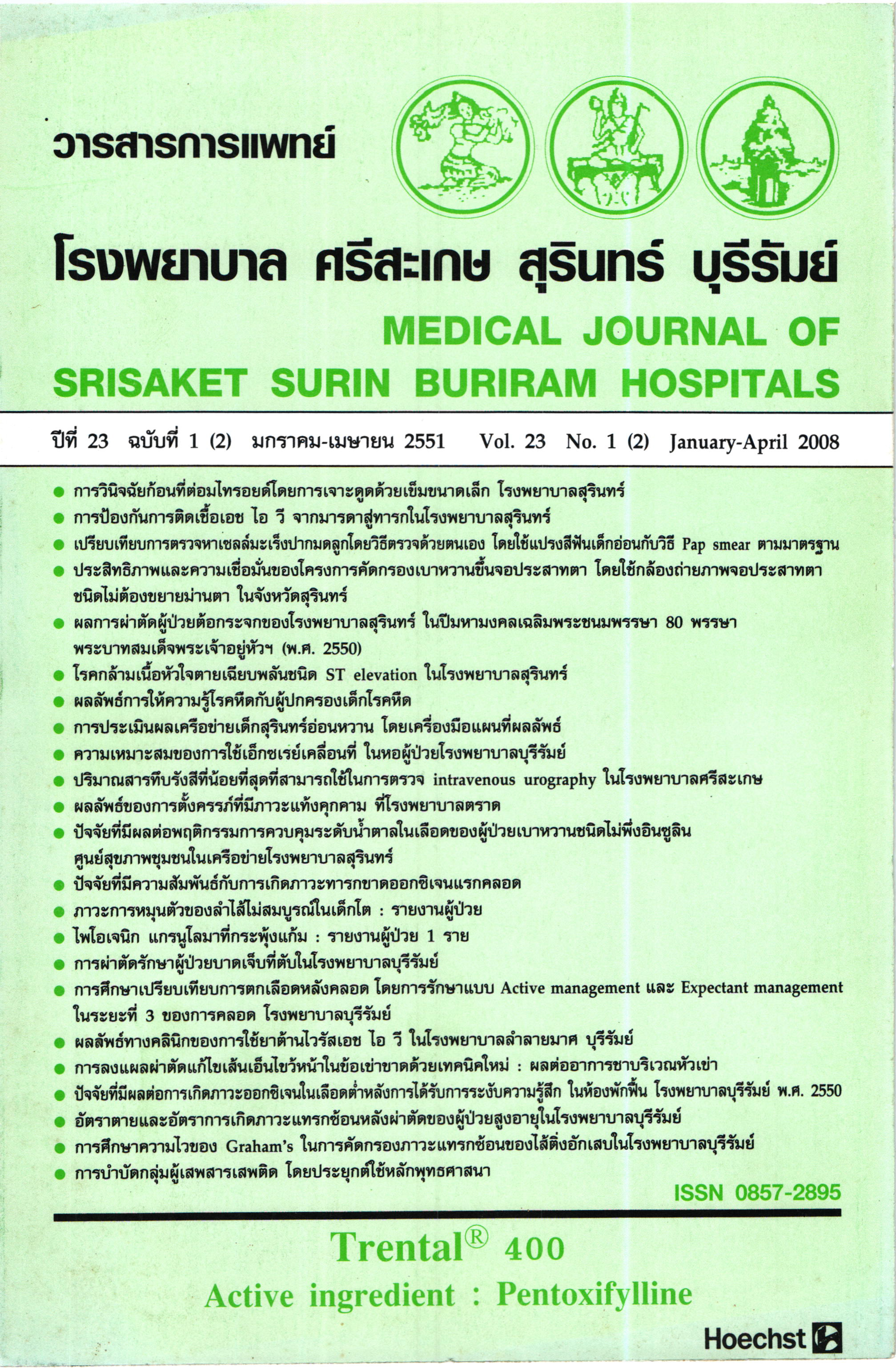การศึกษาเปรียบเทียบการตกเลือดหลังคลอด โดยการรักษาแบบ Active management และ Expectant management ในระยะที่ 3 ของการคลอด โรงพยาบาลบุรีรัมย์
Main Article Content
บทคัดย่อ
หลักการและเหตุผล: การตกเลือดหลังคลอดเป็นสาเหตุสำคัญที่สุดที่ทำให้มารดาเสียชีวิต ซึ่งสาเหตุ ของการตกเลือดหลังคลอดส่วนใหญ่เกิดจากมดลูกหดรัดตัวไม่ดี แม้ในปัจจุบัน โรงพยาบาลบุรีรัมย์ได้นำเทคนิคการช่วยการคลอดแบบก้าวหน้าในระยะที่ 3 ของ การคลอดมาใช้แต่ยังพบอัตราการตกเลือดหลังคลอดสูง
วัตถุประสงค์: เพื่อเปรียบเทียบผลการรักษาแบบ Active management และ Expectant management ในระยะที่ 3 ของการคลอด ในเรื่องปริมาณการเสียเลือดหลัง คลอด การตกเลือดหลังคลอด ระยะเวลาที่ใช้ในการคลอด และอาการแทรกซ้อน หลังคลอดภายใน 24 ชั่วโมง
รูปแบบการวิจัย: การวิจัยครั้งนี้เป็นการวิจัยแบบทดลอง (Experimental research) ชนิด Clinical trial
กลุ่มตัวอย่าง: ผู้มาคลอดปกติในโรงพยาบาลบุรีรัมย์ตั้งแต่ 1 เมษายน ถึง 30 กรกฎาคม 2550
ผลการศึกษา: ผู้คลอดทั้งหมด 189 คน ใช้การสุ่มเข้ากลุ่ม 3 กลุ่ม ๆ ละ 63 คน กลุ่มตัวอย่าง มีลักษณะข้อมูลส่วนบุคคลไม่แตกต่างอย่างมีนัยสำคัญทางสถิติ ปริมาณการ สูญเสียเลือดเฉลี่ยจากการชั่งน้ำหนัก 308.05, 266.17, 299.10 มิลลิลิตร ในกลุ่ม ที่ 1 กลุ่มที่ 2 และกลุ่มควบคุมตามลำดับ ปริมาณการสูญเสียเลือดเฉลี่ยจาก การคาดคะเน 205.36, 201.48, 217.48 มิลลิลิตรในกลุ่มที่ 1 กลุ่มที่ 2 และกลุ่ม ควบคุมตามลำดับ ใช้ระยะเวลาในการคลอดระยะที่ 3 เฉลี่ย 5.50, 6.35, 6.14 นาที ในกลุ่มที่ 1 กลุ่มที่ 2 และกลุ่มควบคุมตามลำดับ ความแตกต่างของ ค่าฮีมาโตคริตก่อนคลอดและหลังคลอด 24 ชั่วโมง เฉลี่ยร้อยละ 1.37, 3.97, 3.77 ในกลุ่มที่ 1 กลุ่มที่ 2 และกลุ่มควบคุมตามลำดับ การหลังตกเลือดหลังคลอด เฉลี่ยร้อยละ 12.6, 7.94, 7.94 ในกลุ่มที่ 1 กลุ่มที่ 2 และกลุ่มควบคุมตามลำดับ
สรุป: ปริมาณการสูญเสียเลือดและระยะเวลาในการคลอดระยะที่ 3 ค่าแตกต่าง ฮีมาโตคริตก่อนคลอดและหลังคลอด 24 ชั่วโมง การตกเลือดหลังคลอดอาการ แทรกซ้อนหลังคลอดภายใน 24 ชั่วโมง ไม่แตกต่างอย่างมีนัยสำคัญทางสถิติ จึง ควรพัฒนาการช่วยคลอดแบบก้าวหน้าในระยะที่ 3 ของการคลอดให้มีประสิทธิภาพ ยิ่งขึ้น โดยทำหัตถการนี้โดยผู้ทำคลอดที่มีความชำนาญ
คำสำคัญ: Active management, expectant management, third stage of labor, postpartum hemorrhage
Article Details
เอกสารอ้างอิง
2. งานห้องคลอด กลุ่มงานสูติ-นรีเวชกรรม. รายงานผู้คลอดประจำปี งานห้องคลอด กลุ่มงานสูตินรีเวชกรรม โรงพยาบาลบุรีรัมย์ ปี พ.ศ. 2545-2549. (เอกสารอัดสำเนา)
3. Maughan Karen L, Heim Steven W., Galazka Sim S. Preventing Postpartum Hemorrhage : Managing the Third Stage of Labor. AAFP 2006;73(6):1025-8.
4. World Health Organization. Active management of the third stage. In : Department of Reproductive Health and Research Family and Community health World Health Organization. Integrated Management of Pregnancy and Childbirth Managing complication in pregnancy and childbirth : A guide for midwives and doctors. India : World Health Organization; 2003. : c 73-5
5. Fawcus S. Treatments for primary postpartum haemorrhage. In : The WHO Reproductive Health Library RHL Informing Best Practice in Reproductive Health. No. 8 ed. Oxford : Update Software; 2005.
6. Abalos E. Active versus expectant management in the third stage of labour. In : The WHO Reproductive Health Library RHL Informing Best Practice in Reproductive Health. No. 8 ed. Oxford : Update Software; 2005.
7. Zamora LA. A randomized controlled trial of oxytocin administered at the end of the second stage of labour versus administered at the end of the third stage of labour in the prevention of postpartum hemorrhage. Philipp J Obstet Gynecol 1999 ; 23(4) : 125-33.
8. Prendeville WJ, Harding JE, Elbourne DR, Stirrat GM. The Brital third stage of trial : Active versus Physiological management of third stage of labour. BMJ 1998;297(6659):1295-3.
9. Thilanganathan B, Cutner A, Latimer J, Beard R. Management of third stage of labour in woman at low risk of postpartum hemorrhage. Eur J Obstet Gynecol Reprod Biol 1993;48(1):19-22.
10. Sukprasert M, Choktanasiri W, Ayudhya NI, et al. Increase accuracy of visual estimation of blood loss from education programme. J Med Assoc Thai 2006 ; 89 (Suppl 4) : s54-9.
11. Fenton JJ, Baumeister LM, Fogarty J. Active management of the third stage of labor among American Indian Women. Fam Med 2005;37(6):410-4.


